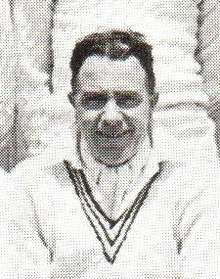Ken James (cricketer)
 Ken James in 1934 | ||||||||||||||||||||||||||||||||||||||||
| Personal information | ||||||||||||||||||||||||||||||||||||||||
|---|---|---|---|---|---|---|---|---|---|---|---|---|---|---|---|---|---|---|---|---|---|---|---|---|---|---|---|---|---|---|---|---|---|---|---|---|---|---|---|---|
| Full name | Kenneth Cecil James | |||||||||||||||||||||||||||||||||||||||
| Born |
12 March 1904 Wellington, New Zealand | |||||||||||||||||||||||||||||||||||||||
| Died |
21 August 1976 (aged 72) Palmerston North, New Zealand | |||||||||||||||||||||||||||||||||||||||
| Batting style | Right-handed | |||||||||||||||||||||||||||||||||||||||
| Role | Wicketkeeper-batsman | |||||||||||||||||||||||||||||||||||||||
| International information | ||||||||||||||||||||||||||||||||||||||||
| National side | ||||||||||||||||||||||||||||||||||||||||
| Career statistics | ||||||||||||||||||||||||||||||||||||||||
| ||||||||||||||||||||||||||||||||||||||||
| Source: Cricinfo | ||||||||||||||||||||||||||||||||||||||||
Kenneth Cecil James (12 March 1904 – 21 August 1976), was a cricketer who played for Wellington, Northamptonshire and New Zealand.
A wicket-keeper and a useful batsman, James first played for Wellington in 1923 and came to England with the first New Zealand touring party in 1927 ostensibly as second string to Tom Lowry. But he quickly made the wicket-keeping position his own, with 85 dismissals on the tour, including eight at Derby. His understanding of the spin of Bill Merritt, the touring team's most successful bowler, was especially noted. No Test matches were played on the 1927 tour.
James was first-choice wicket-keeper for New Zealand's first Test matches in 1929-30 against England, and again on the tour of England in 1931, and in the home series against South Africa in 1931-32 and against England the following season. In 11 Tests he made 16 dismissals but failed completely as a batsman, scoring only 52 runs in total.
But James then left New Zealand for England to qualify by residence as a county player for Northamptonshire, becoming the regular wicket-keeper from 1936 to 1939 and being joined there by Merritt. For a very weak county — Northamptonshire failed to win a single match for four years from May 1935 — James was notable not only for his wicket-keeping but also increasingly as a batsman, and in 1938, he scored more than 1,000 runs and made two centuries.[1]
James served in the Royal New Zealand Air Force during the Second World War and then returned to New Zealand, where he played a few more first-class matches before retiring to run a public house. He died at Palmerston North.
References
- ↑ "First-class batting and fielding in each season by Ken James". CricketArchive. Retrieved 7 May 2016.
External links
- Player profile: Ken James from CricketArchive
- Player profile: Ken James from ESPNcricinfo (includes Wisden obituary)